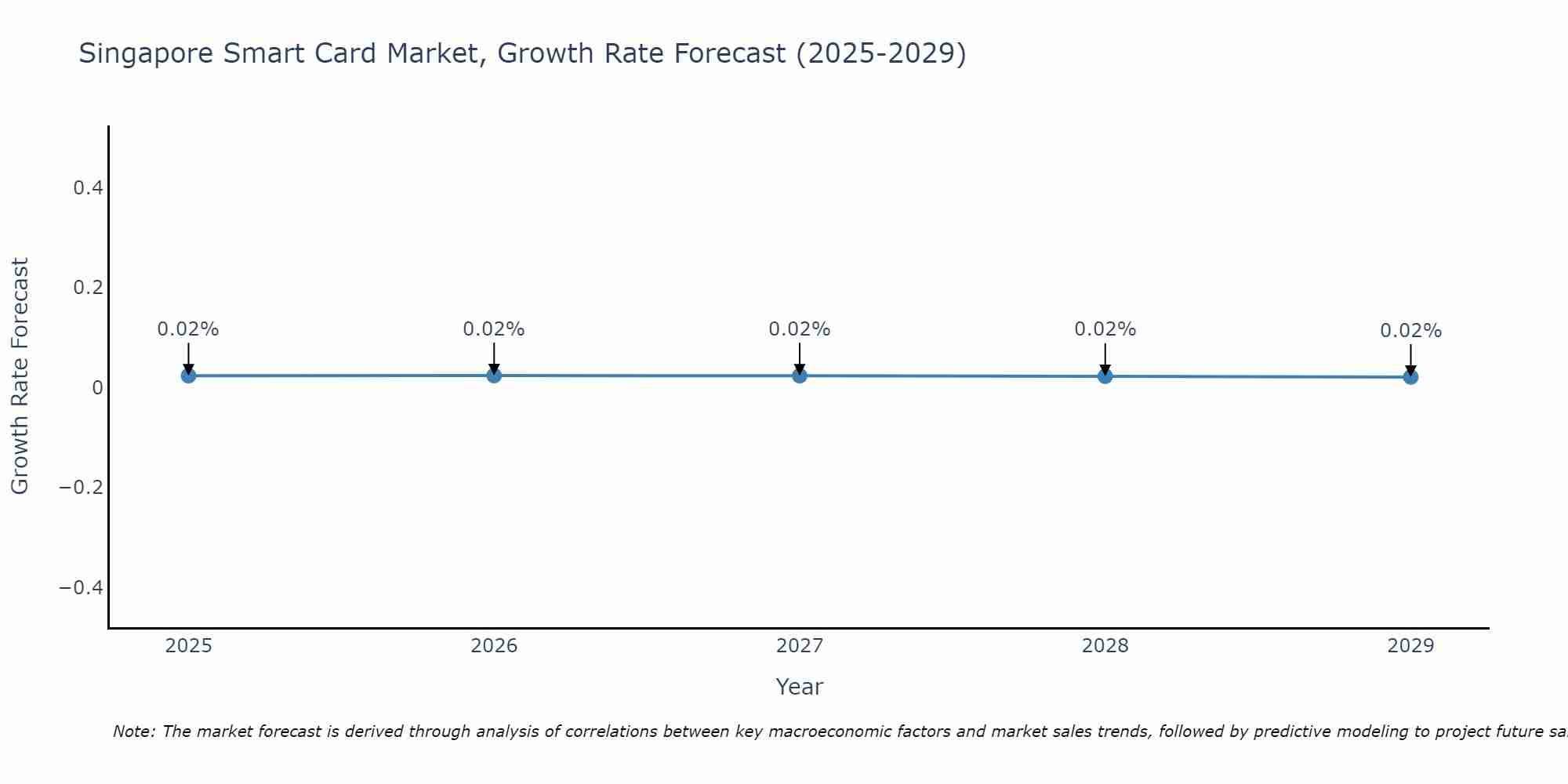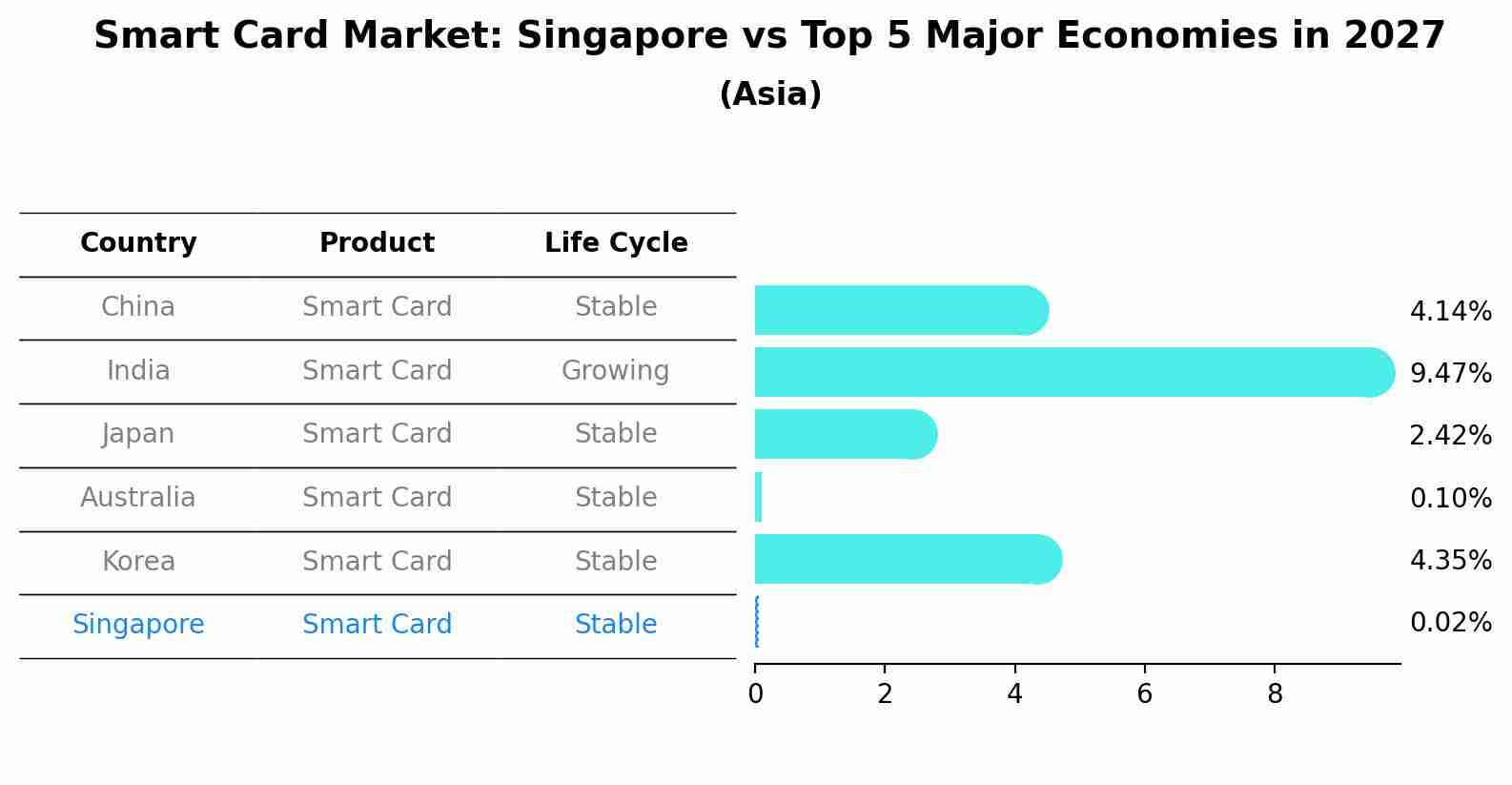Singapore Smart Card Market (2025-2031) Outlook | Value, Industry, Growth, Companies, Share, Revenue, Analysis, Trends, Size & Forecast
| Product Code: ETC081886 | Publication Date: Jun 2021 | Updated Date: Apr 2025 | Product Type: Report | |
| Publisher: 6Wresearch | No. of Pages: 70 | No. of Figures: 35 | No. of Tables: 5 | |
Singapore Smart Card Market Size Growth Rate
The Singapore Smart Card Market is projected to witness mixed growth rate patterns during 2025 to 2029. Growth accelerates to 0.02% in 2026, following an initial rate of 0.02%, before easing to 0.02% at the end of the period.

Smart Card Market: Singapore vs Top 5 Major Economies in 2027 (Asia)
In the Asia region, the Smart Card market in Singapore is projected to expand at a stable growth rate of 0.02% by 2027. The largest economy is China, followed by India, Japan, Australia and South Korea.

Singapore Smart Card Market Synopsis
The Singapore smart card market is expected to witness steady growth, driven by the increasing adoption of contactless payment solutions, digital identification, and security applications. Smart cards play a vital role in enhancing convenience and security in various sectors, including finance, transportation, and healthcare. As Singapore continues to advance its digital infrastructure, the smart card market is likely to expand. Market participants may focus on developing secure and multifunctional smart card solutions to cater to diverse industry needs.
Drivers of the Market
The Singapore smart card market is driven by the country`s commitment to digitalization and technological advancement. Smart cards are widely used for various purposes, including payment systems, identification, access control, and public transportation. Singapore push for a cashless society and the adoption of contactless payment methods contribute to the growth of smart card usage. Additionally, the government`s initiatives to enhance security and streamline services through smart cards further propel market expansion.
Challenges of the Market
The Singapore smart card market is expected to continue its growth trajectory, driven by increased adoption in sectors like banking, transportation, and healthcare. Challenges include cybersecurity threats, evolving technology standards, and the need for seamless integration with digital ecosystems. Strengthening security measures and staying at the forefront of technological advancements will be critical for market players.
COVID-19 Impact on the Market
The COVID-19 pandemic brought about changes in consumer behavior that impacted the Singapore smart card market. Smart cards are used in various applications, including contactless payments, access control, and transportation. During the pandemic, the preference for contactless payment methods increased as consumers sought safer ways to make transactions. This shift positively impacted the smart card market, especially in the payment and public transportation sectors. The demand for contactless access control systems also saw growth as companies and institutions prioritized health and safety measures. As Singapore adapted to the new normal, the smart card market continued to evolve, with an emphasis on security and convenience. The market is poised for further growth as digitalization and contactless technologies become integral to daily life.
Key Players in the Market
The Singapore smart card market is on the rise, fueled by advancements in technology and the need for secure identification and payment solutions. Major players in this sector are Gemalto (Thales Group), NXP Semiconductors, and Infineon Technologies.
Key Highlights of the Report:
- Singapore Smart Card Market Outlook
- Market Size of Singapore Smart Card Market, 2024
- Forecast of Singapore Smart Card Market, 2031
- Historical Data and Forecast of Singapore Smart Card Revenues & Volume for the Period 2021-2031
- Singapore Smart Card Market Trend Evolution
- Singapore Smart Card Market Drivers and Challenges
- Singapore Smart Card Price Trends
- Singapore Smart Card Porter's Five Forces
- Singapore Smart Card Industry Life Cycle
- Historical Data and Forecast of Singapore Smart Card Market Revenues & Volume By Types for the Period 2021-2031
- Historical Data and Forecast of Singapore Smart Card Market Revenues & Volume By Contact Cards for the Period 2021-2031
- Historical Data and Forecast of Singapore Smart Card Market Revenues & Volume By Contactless cards for the Period 2021-2031
- Historical Data and Forecast of Singapore Smart Card Market Revenues & Volume By Multi-component cards for the Period 2021-2031
- Historical Data and Forecast of Singapore Smart Card Market Revenues & Volume By Component for the Period 2021-2031
- Historical Data and Forecast of Singapore Smart Card Market Revenues & Volume By Memory-based for the Period 2021-2031
- Historical Data and Forecast of Singapore Smart Card Market Revenues & Volume By Microcontroller-based for the Period 2021-2031
- Historical Data and Forecast of Singapore Smart Card Market Revenues & Volume By Application for the Period 2021-2031
- Historical Data and Forecast of Singapore Smart Card Market Revenues & Volume By BFSI for the Period 2021-2031
- Historical Data and Forecast of Singapore Smart Card Market Revenues & Volume By Government for the Period 2021-2031
- Historical Data and Forecast of Singapore Smart Card Market Revenues & Volume By Telecommunication for the Period 2021-2031
- Historical Data and Forecast of Singapore Smart Card Market Revenues & Volume By Retail for the Period 2021-2031
- Historical Data and Forecast of Singapore Smart Card Market Revenues & Volume By Healthcare for the Period 2021-2031
- Historical Data and Forecast of Singapore Smart Card Market Revenues & Volume By Hospitality for the Period 2021-2031
- Historical Data and Forecast of Singapore Smart Card Market Revenues & Volume By Others for the Period 2021-2031
- Singapore Smart Card Import Export Trade Statistics
- Market Opportunity Assessment By Types
- Market Opportunity Assessment By Component
- Market Opportunity Assessment By Application
- Singapore Smart Card Top Companies Market Share
- Singapore Smart Card Competitive Benchmarking By Technical and Operational Parameters
- Singapore Smart Card Company Profiles
- Singapore Smart Card Key Strategic Recommendations
Frequently Asked Questions About the Market Study (FAQs):
1 Executive Summary |
2 Introduction |
2.1 Key Highlights of the Report |
2.2 Report Description |
2.3 Market Scope & Segmentation |
2.4 Research Methodology |
2.5 Assumptions |
3 Singapore Smart Card Market Overview |
3.1 Singapore Country Macro Economic Indicators |
3.2 Singapore Smart Card Market Revenues & Volume, 2021 & 2031F |
3.3 Singapore Smart Card Market - Industry Life Cycle |
3.4 Singapore Smart Card Market - Porter's Five Forces |
3.5 Singapore Smart Card Market Revenues & Volume Share, By Types, 2021 & 2031F |
3.6 Singapore Smart Card Market Revenues & Volume Share, By Component, 2021 & 2031F |
3.7 Singapore Smart Card Market Revenues & Volume Share, By Application, 2021 & 2031F |
4 Singapore Smart Card Market Dynamics |
4.1 Impact Analysis |
4.2 Market Drivers |
4.3 Market Restraints |
5 Singapore Smart Card Market Trends |
6 Singapore Smart Card Market, By Types |
6.1 Singapore Smart Card Market, By Types |
6.1.1 Overview and Analysis |
6.1.2 Singapore Smart Card Market Revenues & Volume, By Types, 2021-2031F |
6.1.3 Singapore Smart Card Market Revenues & Volume, By Contact Cards, 2021-2031F |
6.1.4 Singapore Smart Card Market Revenues & Volume, By Contactless cards, 2021-2031F |
6.1.5 Singapore Smart Card Market Revenues & Volume, By Multi-component cards, 2021-2031F |
6.2 Singapore Smart Card Market, By Component |
6.2.1 Overview and Analysis |
6.2.2 Singapore Smart Card Market Revenues & Volume, By Memory-based, 2021-2031F |
6.2.3 Singapore Smart Card Market Revenues & Volume, By Microcontroller-based, 2021-2031F |
6.3 Singapore Smart Card Market, By Application |
6.3.1 Overview and Analysis |
6.3.2 Singapore Smart Card Market Revenues & Volume, By BFSI, 2021-2031F |
6.3.3 Singapore Smart Card Market Revenues & Volume, By Government, 2021-2031F |
6.3.4 Singapore Smart Card Market Revenues & Volume, By Telecommunication, 2021-2031F |
6.3.5 Singapore Smart Card Market Revenues & Volume, By Retail, 2021-2031F |
6.3.6 Singapore Smart Card Market Revenues & Volume, By Healthcare, 2021-2031F |
6.3.7 Singapore Smart Card Market Revenues & Volume, By Hospitality, 2021-2031F |
7 Singapore Smart Card Market Import-Export Trade Statistics |
7.1 Singapore Smart Card Market Export to Major Countries |
7.2 Singapore Smart Card Market Imports from Major Countries |
8 Singapore Smart Card Market Key Performance Indicators |
9 Singapore Smart Card Market - Opportunity Assessment |
9.1 Singapore Smart Card Market Opportunity Assessment, By Types, 2021 & 2031F |
9.2 Singapore Smart Card Market Opportunity Assessment, By Component, 2021 & 2031F |
9.3 Singapore Smart Card Market Opportunity Assessment, By Application, 2021 & 2031F |
10 Singapore Smart Card Market - Competitive Landscape |
10.1 Singapore Smart Card Market Revenue Share, By Companies, 2024 |
10.2 Singapore Smart Card Market Competitive Benchmarking, By Operating and Technical Parameters |
11 Company Profiles |
12 Recommendations |
13 Disclaimer |
- Single User License$ 1,995
- Department License$ 2,400
- Site License$ 3,120
- Global License$ 3,795
Search
Related Reports
- Australia IT Asset Disposal Market (2025-2031) | Strategy, Consumer Insights, Analysis, Investment Trends, Opportunities, Growth, Size, Share, Industry, Revenue, Segments, Value, Segmentation, Supply, Forecast, Restraints, Outlook, Competition, Drivers, Trends, Demand, Pricing Analysis, Competitive, Strategic Insights, Companies, Challenges
- UAE Building Thermal Insulation Market Outlook (2025-2031) | Revenue, Companies, Share, Trends, Growth, Size, Forecast, Industry, Analysis & Value
- Portugal Electronic Document Management Market (2025-2031) | Strategy, Consumer Insights, Analysis, Investment Trends, Opportunities, Growth, Size, Share, Industry, Revenue, Segments, Value, Segmentation, Supply, Forecast, Restraints, Outlook, Competition, Drivers, Trends, Demand, Pricing Analysis, Competitive, Strategic Insights, Companies, Challenges
- France Electronic Document Management Market (2025-2031) | Strategy, Consumer Insights, Analysis, Investment Trends, Opportunities, Growth, Size, Share, Industry, Revenue, Segments, Value, Segmentation, Supply, Forecast, Restraints, Outlook, Competition, Drivers, Trends, Demand, Pricing Analysis, Competitive, Strategic Insights, Companies, Challenges
- Portugal Occupational Health & Safety Services Market (2025-2031) | Strategy, Consumer Insights, Analysis, Investment Trends, Opportunities, Growth, Size, Share, Industry, Revenue, Segments, Value, Segmentation, Supply, Forecast, Restraints, Outlook, Competition, Drivers, Trends, Demand, Pricing Analysis, Competitive, Strategic Insights, Companies, Challenges
- Netherlands Occupational Health and Safety Services Market (2025-2031) | Strategy, Consumer Insights, Analysis, Investment Trends, Opportunities, Growth, Size, Share, Industry, Revenue, Segments, Value, Segmentation, Supply, Forecast, Restraints, Outlook, Competition, Drivers, Trends, Demand, Pricing Analysis, Competitive, Strategic Insights, Companies, Challenges
- Belgium and Luxembourg Facility Management Market (2025-2031) | Strategy, Consumer Insights, Analysis, Investment Trends, Opportunities, Growth, Size, Share, Industry, Revenue, Segments, Value, Segmentation, Supply, Forecast, Restraints, Outlook, Competition, Drivers, Trends, Demand, Pricing Analysis, Competitive, Strategic Insights, Companies, Challenges
- Russia Women Intimate Apparel Market (2025-2031) | Strategy, Consumer Insights, Analysis, Investment Trends, Opportunities, Growth, Size, Share, Industry, Revenue, Segments, Value, Segmentation, Supply, Forecast, Restraints, Outlook, Competition, Drivers, Trends, Demand, Pricing Analysis, Competitive, Strategic Insights, Companies, Challenges
- Africa Chocolate Market (2025-2031) | Size, Share, Trends, Growth, Revenue, Analysis, Forecast, industry & Outlook
- Global Hydroxychloroquine And Chloroquine Market (2025-2031) | Industry, Trends, Size, Outlook, Growth, Value, Companies, Revenue, Analysis, Share, Forecast
Industry Events and Analyst Meet
Our Clients
Whitepaper
- Middle East & Africa Commercial Security Market Click here to view more.
- Middle East & Africa Fire Safety Systems & Equipment Market Click here to view more.
- GCC Drone Market Click here to view more.
- Middle East Lighting Fixture Market Click here to view more.
- GCC Physical & Perimeter Security Market Click here to view more.
6WResearch In News
- Doha a strategic location for EV manufacturing hub: IPA Qatar
- Demand for luxury TVs surging in the GCC, says Samsung
- Empowering Growth: The Thriving Journey of Bangladesh’s Cable Industry
- Demand for luxury TVs surging in the GCC, says Samsung
- Video call with a traditional healer? Once unthinkable, it’s now common in South Africa
- Intelligent Buildings To Smooth GCC’s Path To Net Zero













